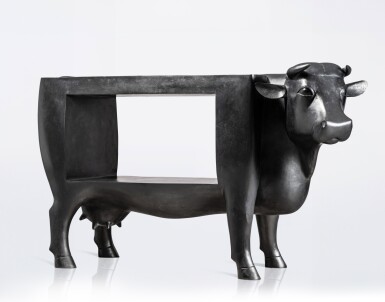Important Design
Important Design

Property from an Important European Collection
François-Xavier Lalanne
"Vache Paysage" (Grand Modèle)
Auction Closed
December 6, 05:52 PM GMT
Estimate
800,000 - 1,200,000 USD
Lot Details
Description
Property from an Important European Collection
François-Xavier Lalanne
"Vache Paysage" (Grand Modèle)
2007
number 2 from an edition of 8 plus 4 artist's proofs
patinated bronze
impressed LALANNE, monogrammed fxl, dated 2007 and numbered 2/8
49¼ x 84⅝ x 31½ in. (125.7 x 215 x 80 cm)
Les Lalanne at Fairchild, exh. cat., Paul Kasmin Gallery, New York, 2010, n.p. (for a related example)
Paul Kasmin, Claude & François-Xavier Lalanne: Art, Work, Life, New York, 2012, n.p.
Adrien Dannatt, ed., Les Lalanne: Fifty Years of Work 1964-2015, exh. cat., Paul Kasmin Gallery, New York, 2015, p. 95 (for a related example)
Adrien Dannatt, François-Xavier & Claude Lalanne: In the Domain of Dreams, New York, 2018, pp. 5, 24 and 262
Les Lalanne à Trianon, exh. cat., Château de Versailles, Paris, 2021, pp. 92-93 and 135 (for a related example)
Reframing Nature: François-Xavier Lalanne’s Magnificent Vache Paysage
Vache Paysage is one of François-Xavier Lalanne’s most meaningful and carefully utilized figures in his remarkable procession of animal sculptures, at the heart of which is his fascination with the animal and zoological worlds. His respect for the tradition of animalier sculpture and the influence of master François Pompon translate here into the serious, gleaming surfaces of the black patinated bronze and the skilled craftsmanship of its execution, creating a naturalistic effect that contrasts with the Surrealist treatment of the form.
Though the sculpture radiates a singular quality and anthropomorphic presence, it is its defining hollowed-out center that makes it so singular, allowing for viewers to see through the piece and to reveal the paysage behind the animal. This isn’t the first animal that François-Xavier has hollowed out. François-Xavier’s Rhinocretaire series, where the bodies of rhinos morphed into desktops, drawers and hidden compartments, delighted the public and critics alike when its first iteration was shown in 1964. In a similar vein, his later Poisson-Paysage cut a fish in half to incorporate a rectangular framing device allowing for the landscape to be visually integrated into the sculpture.
Les Lalanne liked to play with constraints and design their sculptures in a way that will suit a place or a purpose, meaning that their sculptures are indeed highly complementary to it. Many binaries populate their work: vegetal and animal, masculine and feminine, natural and artificial, interior and exterior. This is cultivated throughout their oeuvre and calls upon the viewer to question such traditional dichotomies and to instead think of their sculptures as inherent components of a living and lived-in environment. One of such examples is their home of Ury, both a place of residence and a working studio that they treated as the center of their fantastical bestiary.
The recent exhibition of a Vache Paysage in the Trianon gardens of Versailles is a testimony to the very essence of the piece. Displayed in a pastoral setting, with luscious greenery, superb flora and Lalanne moutons seen in a distance, the Vache came to life, its hollow interior functioning both as a framing device for the nature surrounding it as well as a mise-en-abyme device questioning the boundaries between art and reality. Quite literally through the piece, François-Xavier invites us to pay closer attention to our environment, to the paysage made visible by the cow in a manner that frames the landscape as a work of art in and of itself.
You May Also Like










